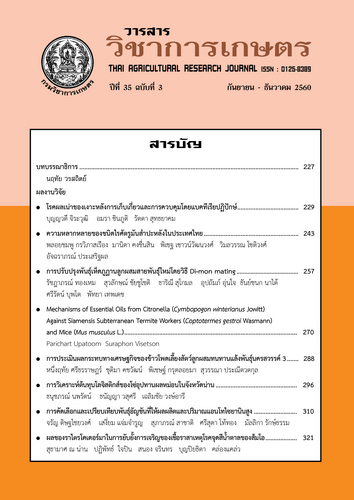Mechanisms of Essential Oils from Citronella (Cymbopogon winterianus Jowitt) Against Siamensis Subterranean Termite Workers (Coptotermes gestroi Wasmann) and Mice (Mus musculus L.)
DOI:
https://doi.org/10.14456/thaidoa-agres.2017.8คำสำคัญ:
Coptotermes gestroi Wasmann, Mus musculus L., Mechanisms, Citronella essential oilsบทคัดย่อ
This work aimed to evaluate the in vivo and in vitro toxicity of essential oils from citronella (Cymbopogon winterianus Jowitt) extract by tasting as contact and fumigation methods against Siamensis termites (Coptotermes gestroi Wasmann). The in vivo and in vitro acute oral toxicity were evaluated with mice (Mus musculus L.). The CRD with 5 replicates for all experiments was designed. Probit analysis was used to elucidate LC50 for termites and LD50 for mice. The in vivo LC50on the 14th day using the contact method
showed ca. 0.54 mg/g and the fumigation method showed ca. 0.02 mg/g of essential oils against termite workers. This is an indication that the in vivo fumigation method showed significantly more toxic against termites than the contact method by 27.02 fold. The in vivo oral LD50of essential oils showed ca. 5.81 g/kg body weight for male and ca.17.42 g/kg body weight for female at the 24th hour. The in vitro fumigation method also exhibited ca. <2-3 fold inhibited acetylcholinesterases (AChE) and glutathione-S-transferases (GSTs) and ca. <1.5 fold inhibited esterases (ESTs) against termites compare to the untreated termites.
While the in vitro in liver of mice exhibited ca. < 2 fold AChE and GSTs and ca. < 0.5 fold inhibited ESTs compare to the untreated mice control. But the contact method was likely nonsignificant in vitro enzymes activity compare to untreated mice control for all enzymes assays.
ดาวน์โหลด
เผยแพร่แล้ว
รูปแบบการอ้างอิง
ฉบับ
ประเภทบทความ
สัญญาอนุญาต
ลิขสิทธิ์ (c) 2018 Thai Agricultural Research Journal

อนุญาตภายใต้เงื่อนไข Creative Commons Attribution-NonCommercial-NoDerivatives 4.0 International License.
วารสารวิชาการเกษตร



